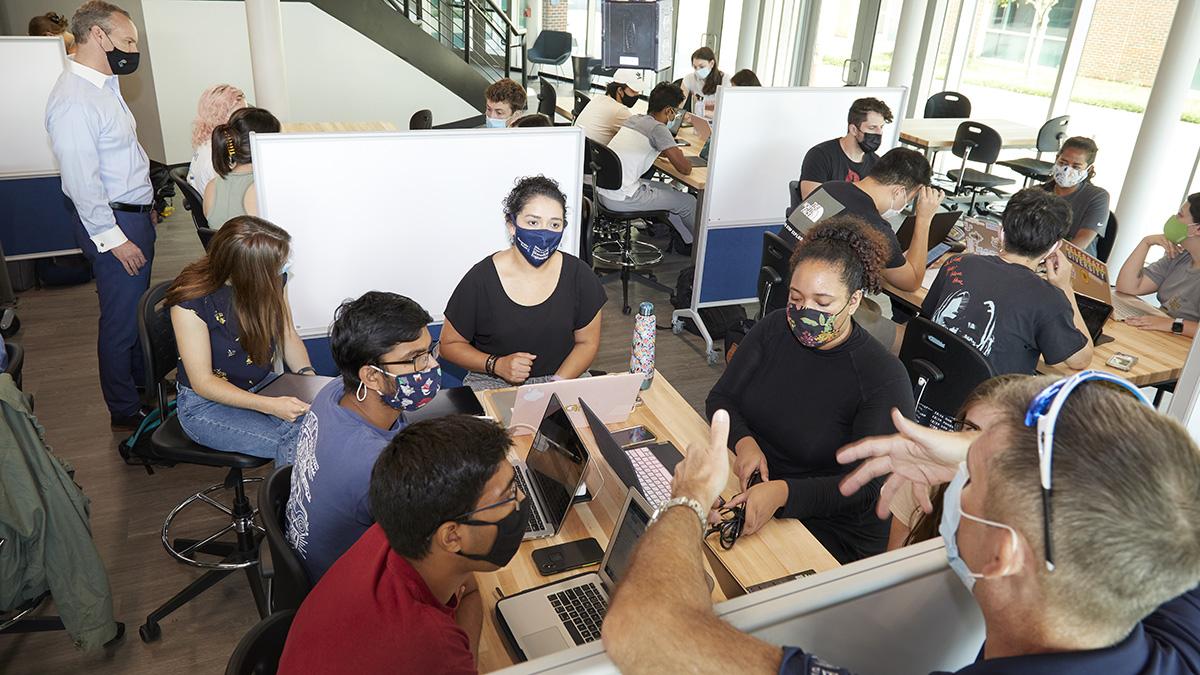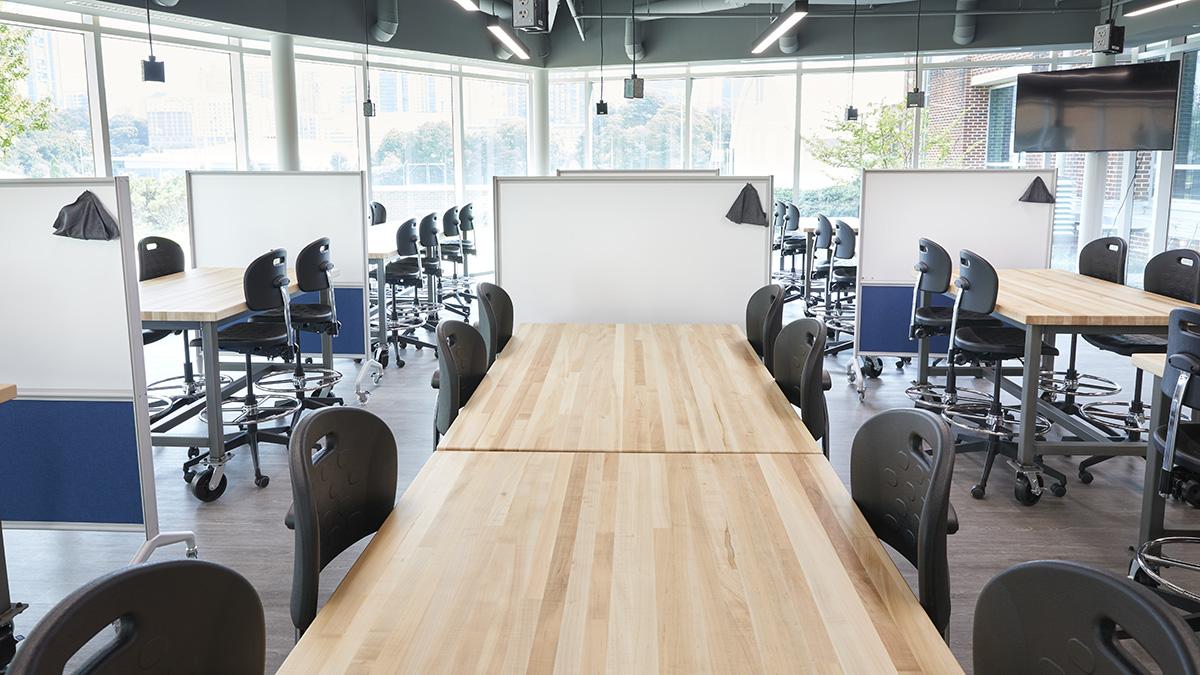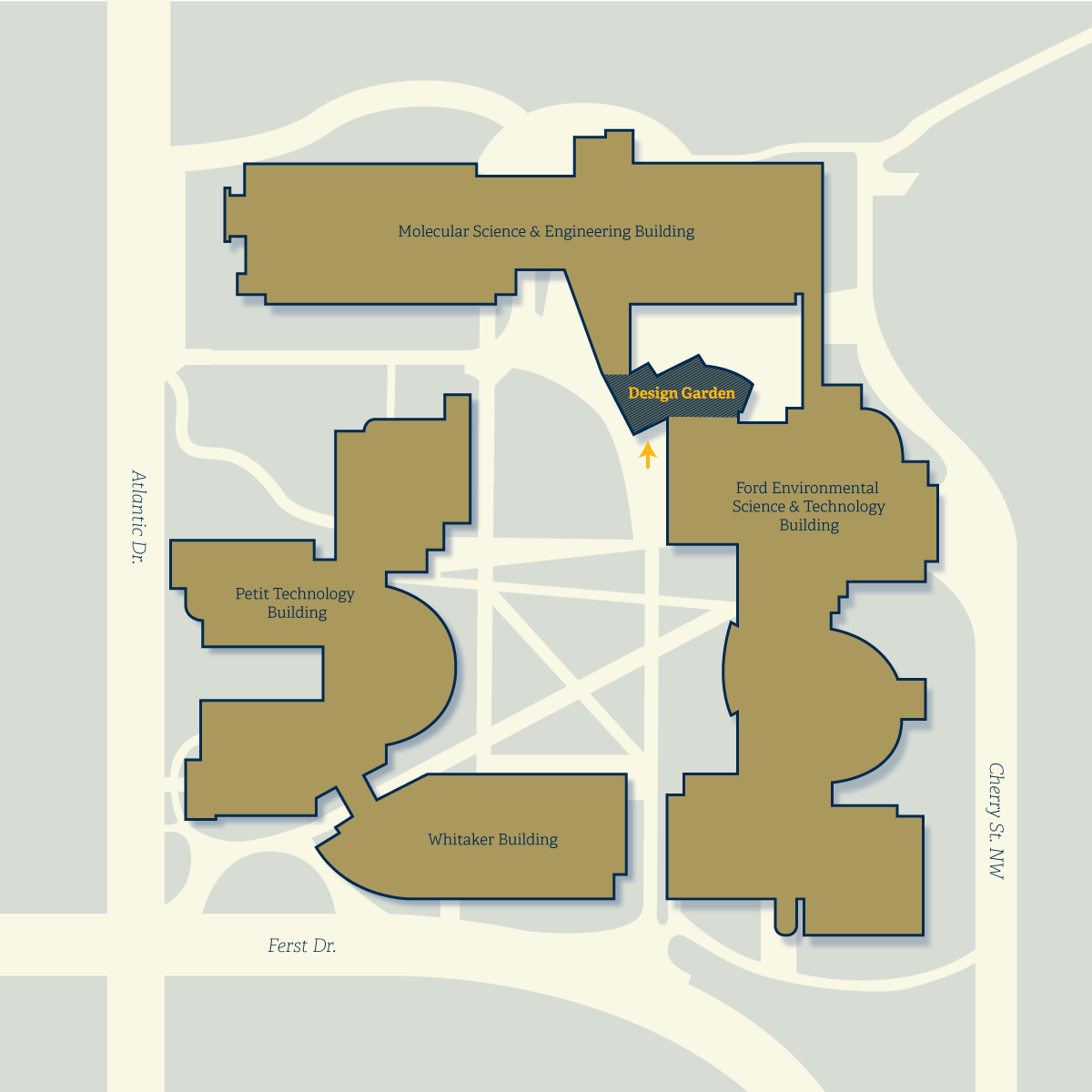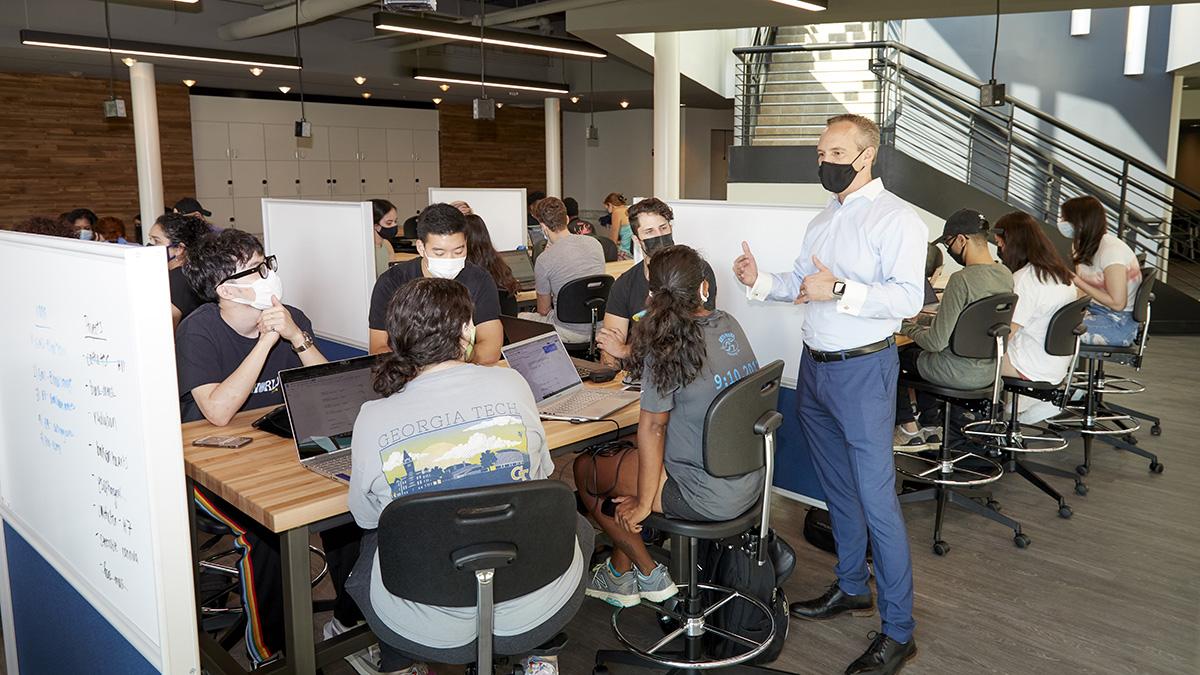Professors of the Practice James Rains, back left, and James Stubbs talk with students about their Capstone Design projects during one of the first classes held in Coulter BME’s new Design Garden space. The collaboration and innovation space is open to biomedical engineering students 24/7 whenever classes aren’t using it. The space opened in August 2021. (Photo: Craig Bromley)
The most visible sign of the new Design Garden approach in the Wallace H. Coulter Department of Biomedical Engineering is a new collaboration and creative space in the BioQuad at Georgia Tech. More on that in a moment.
The Design Garden idea is about those things — collaboration and creativity and design — and it’s also a broader concept about offering opportunities for students studying biomedical engineering at Tech and Emory University.
“We're creating an environment where we can encourage and support students' growth — not just in their learning, but also in their ideas,” said James Rains, professor of the practice and a key architect of the Department’s design curriculum as leader of BME Capstone. “The new space is a location where they can do part of this growing, and it also happens in the classes that we teach, where we're including new content and skills to hopefully educate and inspire our students.”
The Design Garden idea infuses new topics in design and innovation that expand students’ capabilities — teaching them about the regulatory environment, quality control, manufacturing technology, intellectual property, and business development. As Rains puts it, “the big picture.”
“Our students are not just going into one kind of job,” he said. “We want to make sure we're offering the avenues where they can learn about all the different potential career paths for a biomedical engineer.”
These topics are showing up in existing design-related courses, new courses already on the books, and other new courses that faculty members will develop in the future.
“This Design Garden concept is about creating opportunities within and beyond our curriculum to cultivate and support our students’ innovative and entrepreneurial endeavors,” said Susan Margulies, former Wallace H. Coulter Chair of the Department who helped create the idea. “As our Department has grown, so have the many ways our students use engineering design as a pathway to create impact in society. The Design Garden space and related programs are where the creative ideas of Coulter BME students can emerge, grow, and thrive.”
The new Design Garden space includes moveable furniture, plenty of whiteboards, and a skyline view of Midtown Atlanta. Located below the Veterans Resource Center in the Georgia Tech BioQuad, the space triples the amount of design-focused square footage in the Coulter Department of Biomedical Engineering. (Photo: Craig Bromley)
About that space — a beautiful, new open area that’s a substantial down payment on nurturing the seedlings of learning and ideas. It opened for students in the fall.
Located in the northeast corner of the BioQuad at Georgia Tech below the Veterans Resource Center, the newly renovated area will serve as the hub for building a community of innovation and collaboration in the Department that engages students, alumni, clinicians, and companies. It was made possible by a gift from Joan Stanescu and Terrance Hahn, parents of a third-year Coulter BME student who found the idea compelling. Both have material science and engineering backgrounds, and Stanescu has spent much of her career focused on developing and commercializing technology. Her work has included helping set up a nonprofit innovation lab along the France-Switzerland border to support entrepreneurs.
“You’ve got to have a place where cross-functional teams can come together,” Hahn said. “Joan has always been really good at pulling cross-functional teams together. She is always like the center of the wheel, connecting people.”
Stanescu picked up the thought: “It’s such a different feeling when you have a group supporting you; you don’t waste your time. They’ll say, ‘Don’t do this, but do that — that’s a good idea.’ That community is so important in this field.”
Stanescu and Hahn said they resonated with the idea of having a place where people can physically interact, bounce ideas off each other, innovate, and share experiences. And that’s precisely how the Design Garden will function.
The space will host design courses alongside other events and activities, and it triples the design-focused square footage in Coulter BME. Biomedical engineering students will have access 24/7, so teams can gather to work on projects whenever it’s convenient. It’s designed with secure storage so groups can leave their equipment or prototypes and quickly pick up their work anytime — a key limitation of the current classroom space, where students have to pack up whenever they’re not in class to make way for other courses.
For students participating in hackathons, design events, and other kinds of competitions, the space will be a place to work and store their stuff. That’s something the Department hasn’t been able to offer before for the 20-30 teams who come together every year on their own to compete in those kinds of events.
Rains said lots of thought and effort went into making the Design Garden space welcoming so it’s a place where students feel they belong from the get-go.
“We want them using the space at the same time as other teams or groups, so when you're trying to tackle a problem, there's somebody that you may be able to lean on or ask for help — or maybe you can help others with their projects,” Rains said.
He also pointed to the impact of students at every stage of their academic career in Coulter BME working in the same place.
“Imagine you're a freshman or sophomore: You can use this space alongside juniors, seniors, maybe master’s or Ph.D. students, and you can see what your trajectory could be,” he said. “We really love the idea of, say, a capstone student team working right beside a group of first-year students and the potential for synergy there.”
Hahn and Stanescu said they, too, love the opportunities for cross-pollination the Design Garden presents.
“It’s important for young people to learn how to speak with people who are not their age. Freshmen may be intimidated by students who are seniors, but in this environment, that’s encouraged. They get used to asking questions of people who it might be intimidating to ask,” Stanescu said. “You might not have the answer, you might look stupid, but that’s the thing about entrepreneurship: try things and have them fail. And part of that is discussing things with people.”
Professor of the Practice James Rains discusses ideas with students during his Capstone Design course in August 2021. The course meets in the new Design Garden, a dedicated collaboration space for Coulter BME students to work on class projects or their own ideas and innovations. The Design Garden includes secure storage, power at every workstation, and movable furniture to accommodate groups of any size. (Photo: Craig Bromley)
Latest BME News
Jo honored for his impact on science and mentorship
The department rises to the top in biomedical engineering programs for undergraduate education.
Commercialization program in Coulter BME announces project teams who will receive support to get their research to market.
Courses in the Wallace H. Coulter Department of Biomedical Engineering are being reformatted to incorporate AI and machine learning so students are prepared for a data-driven biotech sector.
Influenced by her mother's journey in engineering, Sriya Surapaneni hopes to inspire other young women in the field.
Coulter BME Professor Earns Tenure, Eyes Future of Innovation in Health and Medicine
The grant will fund the development of cutting-edge technology that could detect colorectal cancer through a simple breath test
The surgical support device landed Coulter BME its 4th consecutive win for the College of Engineering competition.











